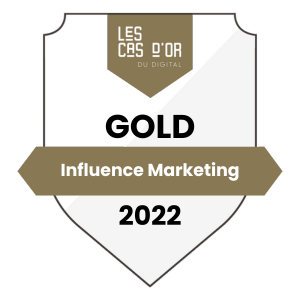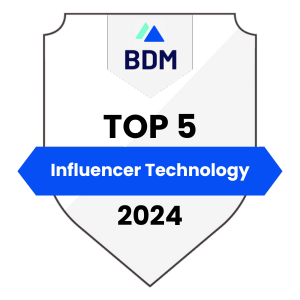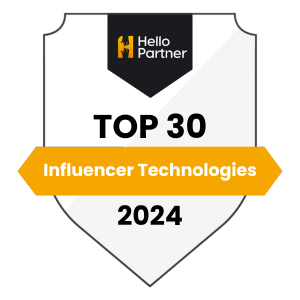Let’s cut to the chase: influencer marketing is here to stay. And not only is it staying, it’s evolving rapidly. The first year of the new decade is proving to be a consequential year in influencer marketing with the rise of new social media channels and a very active new generation. Authenticity and transparency are becoming increasingly important online and it is therefore vital that you do your research before deciding on which influencer to work with. Want to know what 2020 has in store for influencer marketing? Just follow us.
1. Measuring tools and predictions
This year will mark an increase in investment in influence marketing platforms, the number of which has grown significantly in 2019. With the considerable budgets that brands devote to influencer marketing and the constant risk of influencer fraud, especially on Instagram, advertisers can no longer make mistakes when choosing their ambassadors. Social media is crawling with people who deem themselves influencers so finding a reliable partner is not just something that can be done on gut instinct or name recognition. Objective data and numbers will be your best friends as they give you a clear overview of the performance of the influencer and will help you pitch your choices to decision makers.
Only platforms offering a wide range of available data allow, precisely and in real time, to identify relevant and genuine influencers as well as to measure, and ultimately improve, their ROI. New technological developments that increasingly make use of AI already make itpossible to better detect false followers and engagements of an influencer. It is also possible to predict and explain the success or failure of a campaign – with access to results for engagements, but also for actual conversions (traffic, sales) and reactions of reached audiences (comments and sentiments).
Whether used by brands or their agencies, platforms will be a must in 2020 and will evolve with the needs of marketers as well as the emergence of new social networks.
2. Instagram stories
With video content on the rise, influencers are posting more and more Stories and have managed to use it as a powerful tool to increase their Engagement Rate. The Stories function has been successful since its implementation in August 2016 and 400 million people use it on a daily basis. According to Mediakix, regular posts are still taking the top spot on the list of most effective content formats in influencer marketing, but Stories are taking a strong second place with 73% vs. 78% for regular posts.
There are multiple reasons why Stories have taken this list by storm and from a brand’s point of view it’s clear to see that it offers a whole new and very effective engagement opportunity. Stories really create a feeling of being able to directly interact with an influencer. They often give a less polished, more real image of moments or situations than pictures do. Influencers also often ask their followers about their opinion with polls or organize a Q&A session where the audience can ask questions by filling in a form in a Story. Moreover, there is the possibility to go live and answer questions directly or even let followers participate in the live video. If that’s not engagement, we don’t know what is.
Another reason Stories seen as a powerful tool by the brands is that it also offers a huge opportunity to increase the conversion rate because it can use a strong CTA with the ‘Swipe up’ function that redirects viewers to a longer-length video, an e-commerce website or for entering a giveaway.
3. TikTok
Ok, Boomer (and Millennial), the time has come to feel old. Just when you thought you knew everything about Instagram, a newer and younger player enters the market. Taking social media by a storm, TikTok has quickly become the preferred platform for Gen Z. Gaining 800 million active users within 3 years is no easy feat and the numbers are growing as we speak. So what is it that makes this new player in the market stand out from the others? Aren’t there plenty of other apps that allow you to lip sync to a song (yes, there are).
As you know, popular platforms such as Instagram also allows its users to upload (short) videos either via Stories or on your feed. However, TikTok has become the go-to video platform for Gen Z, with 66% of its users being younger than 30 years old. It therefore taps into a whole new generation that is highly internet savvy and, according to 99firms, spends an average of 11 hours per week on their mobile phones. The amount of TikTok users is surging and doesn’t look like it’s slowing down anytime soon.
The attraction of TikTok is mainly related to the ease with which you can turn yourself into a content creator and the appeal of short, TikTok videos last 15 seconds, funny vids. Next to mostly teens lip syncing, there is also plenty of content to be found related to challenges and competitions and that’s exactly where we need to pay attention as they sometimes generate better results than on Instagram. TikTok users, and Gen Z in general, are less susceptible to the old fashioned way of advertising like on Facebook and Instagram and a big part of the appeal lies in the fact that it also doesn’t allow advertising. Their audience is looking for authenticity more than on the aforementioned platforms and creativity is highly regarded. It is therefore crucial to give (almost) complete freedom to the influencer you intent to work with so they can reach the optimal amount of people and promote your brand in the most natural and original, and thus effective, way possible. TikTok is steadily challenging Instagram’s top position in the social media universe and only time will tell which platform will prevail.
4. Long-term ambassadorship
Social media is growing up and so is influencer marketing. It is therefore that we see a change in the duration of partnerships between brands and influencers and it seems we are moving from “Netflix & Chill” towards a more “Facebook official” relationship.
This development shows obvious benefits for both sides. Brands trust that particular influencer and don’t need to invest a lot of time in finding a new influencer for every campaign while the influencer is generally perceived as more authentic and reliable when they commit to only promoting a few products. Authenticity of the brand is also becoming increasingly important for consumers as they are not only looking at the brand and the product, but also at what they stand for.
Using a certain pool of influencers to continuously promote your products and brand, a so called always-on collaboration, is a trend that is becoming increasingly popular as it contributes to the reliability and transparency of the brand compared to one-off campaigns with ever-changing influencers.
5. Mixing up profiles
Another trend that we will be seeing in 2020 is the use of different types of influencers. In the beginning, it was thought that the bigger the influencer, the better. But size doesn’t always matter. Depending on your brand, product and campaign goal, it might be beneficial to opt for smaller, so called micro and nano influencers. Influencers with a smaller audience often provide a more authentic or natural vibe and tend to have a higher engagement rate, while macro influencers give you visibility and buzz faster but at a higher cost. Choosing Macro or Micro influencers doesn’t mean you have to commit to this strategy, experiences have showed us that using different types of influencers can work well throughout the year or even within one campaign. It really depends on your objective, brand offer and budget.
Whichever the goal is, use data to make an informed decision as to have the most effective campaign possible. The number of followers doesn’t always mean everything and finding the right fit for your brand can really increase the ROI on every euro you spent, and isn’t that what we’re all looking for?
6. Virtual influencers
When describing one of the latest trends in influencer marketing we need to look beyond the girl or boy next door and look beyond the ‘real world’: virtual influencers. Imagine your Sims character being a world-famous influencer promoting big brands and having millions of followers, what could go wrong? The first virtual influencer entered Instagram in 2016 and is operated by an LA-based company. Lil Miquela’s gathered 1.9 million followers and she has already starred in a Calvin Klein commercial together with supermodel Bella Hadid.
So what are the advantages of working with a virtual influencer? A study by HypeAuditor shows that virtual influencers tend to have a much higher engagement rate than their human counterparts, almost three times as high. Combine this with a considerably lower investment and you’ve got yourself some pretty strong pros. Lastly, working with virtual influencers is predictable. As a brand, you can control 100% of what the influencer does and how this reflects on your brand and identity.
Now hold your horses, not all that glitters is gold and virtual influencers also lay bare a number of challenges. A study by City AM showed that the depiction of completely perfect ‘persons’ can contribute to people feeling they have to live up to this ‘perfect’ standard. Like with other AI-related issues, virtual influencers are also subject to ethical dilemmas. Questions about ownership, who is behind the character and the potential of engaging 1 on 1 with thousands of followers and thereby establishing deep, personal bonds are legitimate and need to be taken into account when setting the first steps in the virtual influencers arena.
Curious about how these latest trends can benefit your brand? Reach out to us and we’ll be more than happy to help guide you through the digital jungle of influencer marketing.










